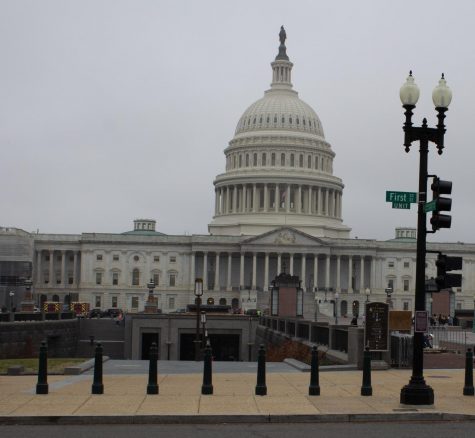Racial disparities in AP classes
How the College Board and Fairfax County are working to make classes more inclusive
Holding a megaphone and a new vision of education, Nelson Luna stands on the steps of Tweed Courthouse demanding school integration. A student activist from New York, he redefined a movement among young people insisting that public schools offer equal education to black and white students. In recent years, Luna and fellow education advocates have shifted their sights on a new target: College Board.
Modern educational inequality varies among schools but is inarguably a nationwide phenomenon. National test scores, graduation rates, and detention rates show racial gaps across the country, indicating a difference among black students in their access to reliable, professional educational resources as a general rule. Within Oakton High School, this gap most clearly realizes itself in Advanced Placement (AP) enrollment. Among white and Asian students, it is around 80% likely that they will take at least one AP class, but among black and Hispanic students, the AP enrollment rate is closer to 50%.
Rebecca Small, an educational specialist for Advanced Academic Programs in Fairfax County, says that culture is the most substantial factor contributing to the disparities between races in AP classes. “There is a culture where people view AP as elite, and unfortunately, some people may feel like that doesn’t always include people of color. This is a deeply-rooted cultural problem.” Historically, AP classes were only offered at elite preparatory schools to help students – usually white males – gain acceptance into Ivy League colleges. At one point, the College Board felt that “not all students are created equal” and that some students are “more special than others.” It wasn’t until the Supreme Court case Brown v. Board of Education that AP classes opened to all students, regardless of race. Ms. Small says, “It took time, but there is now an equity policy within the College Board. But there is always more work to be done.”
The College Board is well-aware of the difference in both AP accessibility and performance among race and ethnicity. Terry Redican, the Vice President of AP Program Delivery, explains that the objective of the College Board is to ensure that AP courses reflect the diversity of individual communities and that all students who are academically ready for AP can participate. While the College Board still has work to do and should be held accountable for it, they have achieved laudable progress in recent years. According to Mr. Redican, the number of underrepresented students scoring three or higher on AP exams in high school over the last ten years is up over 156% – from 87,606 in the class of 2009 to 224,921 in the class of 2019. AP access for students from low-income families is also on the rise as more states, districts, and schools enact policies to cover expenses, and students with financial needs can take AP exams at a reduced cost. The percentage of low-income students participating in AP has nearly doubled in the past ten years.
AP’s counterpart, the International Baccalaureate (IB) program, historically has fewer racial disparities. The IB program differs from AP in its global curriculum supported in over 150 countries across the world, while the AP program is based exclusively in the United States and Canada. There are currently 1,839 IB World Schools in the United States. In contrast, Mr. Redican says that “more schools participate in AP than ever before. Ten years ago, 17,374 schools participated in AP. In 2019, that number grew to 22,678.” Despite fewer racial inequalities, the vice president points to research that cites students enrolled in AP are better prepared for college when compared to the IB diploma. “They are more likely to enroll in college, stay in college, do well in their classes, and graduate on time in four years,” he says.
The College Board continues to mediate the race gap in education through a top-down approach that involves frontline educators and diverse perspectives. Mr. Redican says, “We work closely with state policymakers, school districts, schools, and other partners including the National Science Foundation and College Advising Corps, to expand access to students from all backgrounds.”
Here in Fairfax County Public Schools (FCPS), representatives are also working hard to combat equity issues. The county used to require a teacher recommendation for every AP class a student wants to take. New policies allow a student to take any course, regardless of teacher recommendation. FCPS also pays fees for students to take AP classes, assuring that regardless of socioeconomic background, everyone has equal access to AP classes.
Alexis Orr, an African American junior at Oakton High School who currently takes no AP classes. She thinks that “one reason African Americans take fewer APs is that oftentimes teachers don’t take the time to encourage us to push ourselves academically.” In response, Ms. Small says, “I am very disappointed but not surprised. I believe that it is important to encourage all student access to rigorous classes, and we offer cultural sensitivity and training modules to help combat this [teacher bias].” She also adds that the education and involvement of a student’s parents plays an integral role in the student’s course selection. “When a child is a product of two educated parents, the child is encouraged to participate in educating activities, and FCPS tries to promote this through family engagement activities.” By taking steps to inclusivity, more students are likely to take AP classes, and research shows that when schools increase access for AP classes, the average AP and state-level testing scores also increase.
As the College Board and Fairfax County respond to rapidly diversifying schools, educational equity will become more important than ever. Measures like financial grants and relaxed enrollment rules help to provide equal access to education, but they’re not enough to close the gap entirely. Educators and policymakers alike will need to innovate in the coming years to address the needs of students like Alexis, who are at risk of being left behind because of factors outside of their control.






